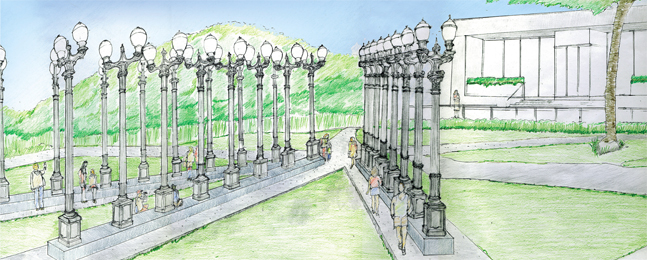Chris Burden Sculpture to Illuminate Campus

Courtesy Chris Burden Studio
Artist’s rendering of Light of Reason, to be installed in front of the Rose.
This fall, a new work of public sculpture will brighten the entrance to the Rose Art Museum — and add radiance to the entire Brandeis campus.
Critically acclaimed artist Chris Burden, a Boston native, has been commissioned to create a major installation inspired by the three torches, three hills and three Hebrew letters in the university’s seal.
Burden’s design will use recycled Victorian lampposts and concrete benches to form three branches that fan out from the Rose entrance, creating an inviting gateway to the museum and a dynamic outdoor space for the Brandeis community. The work is already being discussed as a setting for a broad range of student and community activities, says Christopher Bedford, the Henry and Lois Foster Director of the museum.
“My hope is that this sculpture will be an icon for Brandeis and for the Rose Art Museum, a portal into the museum for visitors ranging from our campus community to international patrons, and a nexus of student activity and ritual from the time of its unveiling into the foreseeable future,” says Bedford.
The installation’s title, Light of Reason, borrows from a well-known line written by the university’s namesake, Supreme Court Justice Louis Dembitz Brandeis: “If we would guide by the light of reason, we must let our minds be bold.”
Burden has been heralded as a creator of “epoch-defining work” and “one of the most important American artists to emerge since 1970” by New York City’s New Museum. In 2008, the Los Angeles County Museum of Art installed at its entryway a Burden sculpture, Urban Light, consisting of 202 restored street lamps from the 1920s and ’30s.
Brandeis is funding the installation through the museum’s special acquisition funds, which can be used only to purchase art. The landmark sculpture continues the Rose’s commitment to collecting and exhibiting the art of the present, and underscores Brandeis’ history of radical innovation in the visual arts, says Bedford.
“I want to find a way to turn the museum inside out so that our deepest artistic commitments extend beyond the museum walls, becoming integrated psychically into the social lives of students, faculty and staff,” he says.
